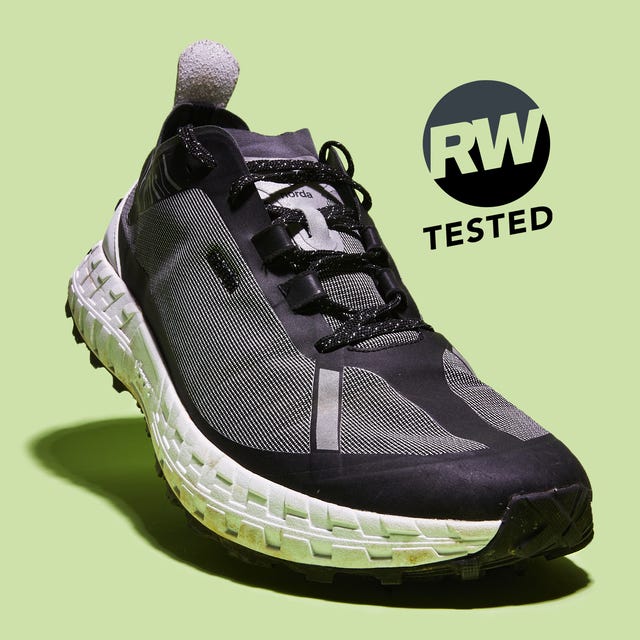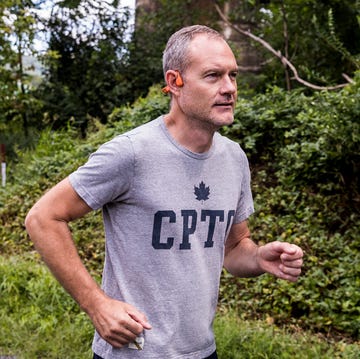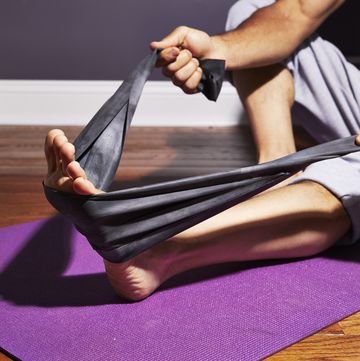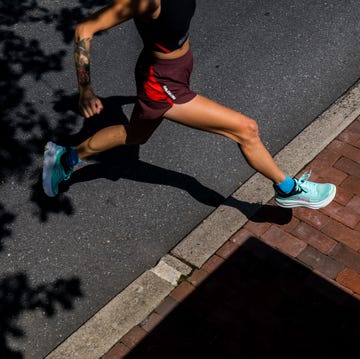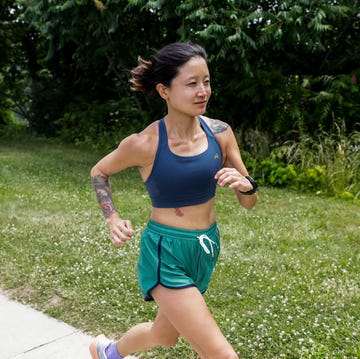The RW Takeaway: Vibram and Dyneema run up the price, but this shoe performs admirably on a mix of surfaces.
- Vibram’s midsole is firm but protective on rocky trails
- The Dyneema upper is rip-proof but could benefit from better protection
- The fit needs to be dialed in for the next version
Price: $285
Weight: 9.5 oz (M), 8.1 oz (W)
Drop: 5 mm
Type: Trail
Buy Men’s Buy Women’s More Images
When you shop at a boutique store, you expect luxurious materials and form over function—plus a jaw-dropping price tag. That’s nearly what you’re getting from Norda, one of the hip new kids on the trails. This Montreal-based company made a splash mostly through its use of best-in-class materials and collaboration with Ciele, a stylish hat maker also based in that city to our north. We saw the same strategy from Speedland, the Portland, Oregon, maker of a $375 trail shoe we mentioned in the November/December issue of Runner’s World. The ridiculously high prices are partly a product of the expensive materials used, as well as the fact that these small companies can’t do the volume of larger brands, and thus they don’t get the same discounts on materials and production. But the shoe delivers a good on-trail experience if you’re willing to crack open your wallet.
How We Tested
Our usual shoe review process begins with at least a dozen sample pairs of the same model—a couple pairs are reserved for mechanical testing in our lab, while the remainder is put on the feet of our wear-testers who collectively log hundreds of miles over a variety of conditions during a month-long test. Because Norda is a new, small brand with limited pairs available when we began testing, they were only able to provide us a couple pairs, so Pat Heine-Holmberg, our resident ultrarunner, and I laced up the samples and hit our local trails. We put the shoes through a mix of terrain, logging miles on everything from a crushed gravel rail trail to extremely rocky, ankle-breaking singletrack. We also got feedback from a friend we’ve run with and raced against, after he picked up a pair of his own and ran up big mountains with thousands of feet of gain and descent. Between the three of us, there’s no surface we haven’t run over in this shoe, to give you insight into how it performs.
Third-Party Components
For the 001, Norda worked with the Italian rubber company Vibram not only for the shoe’s outsole, but also for its SLE midsole foam. The 001 incorporates both Megagrip and Litebase rubbers, commonly found on a lot of trail shoes, on the bottom to boost grip and confidence on technical ground.
Nick Martire, cofounder of Norda, told me there was a “happy accident” when designing the shoe, which increased the shoe’s traction: Topographical lines on the sole both represent the Canadian Shield and give it an even better bite than lugs alone. Did we notice a difference over other Megagrip soles? Not really.
Join Runner's World+ for unlimited access to the best training tips for runners
But the shoe felt planted, in part thanks to the Hoka-like wide base underfoot. The 001 is exceptionally wide, especially through the midfoot, giving you a lot of surface area to make contact with loose dirt and rocks. On more technical ground, the 5-mm boomerang-shaped lugs conform to rocks and give you confidence when the ground is wet.
Vibram Makes Foam, Too?
Did you know Vibram makes foam midsoles? In fact, it offers them across many of its sole units for boots and casual shoes, but we don’t see these in performance running, as brands showcase their own cushioning technologies. This midsole, though, feels exceptionally firm, especially when you’re running along flat, hard-packed ground and rocky trails. There’s very little impact attenuation happening, which is why we prefer to use the 001 on more technical trails where our own footwork and technique help to naturally soften our footfalls. We found the shoe excelled best when we were on steep trails in New York’s Adirondack mountains or climbing the Kittatinny Ridge in Pennsylvania up to the Appalachian Trail.
The Upper Needs More Protection
Our testers appreciated the roomy forefoot, but we found the midfoot a little sloppy. Runners with narrow feet or low insteps will find that they have to pull the laces so tightly they may run out of room as the eye rows cinch together. In any case, everybody should go up a half size, because the shoe runs short. (Norda sent samples for Pat and me a half-size up and they fit great during our test.)
The upper is made from Dyneema, another premium third-party product. Touted as being lighter and stronger than steel, Dyneema is nearly indestructible when used in a running shoe. That kind of toughness lets Norda build the upper from a single piece of fabric without any overlays or seams. The lightweight fabric, however, offers absolutely no bumper against the rocks and sticks you’ll encounter on rugged trails. During my test runs in the Adirondack Mountains, I was painfully aware of every rock I kicked.
Is It Worth $285?
Far be it for me to suggest what you do with your money. But it’s an undeniable fact that running shoes have gotten more expensive. Nike started it all when it released the original Vaporfly 4% at $250. Nearly every brand followed, releasing “super shoes” that cost two bills or more. Some of those shoes deliver true performance benefits, leading to faster finishing times in races. In the case of Norda, the use of Vibram and Dyneema components drive up the cost of the 001. But, the shoe performs much better than if the company had tried to develop those parts on its own for its debut shoe. Grumpy old runners like myself will gripe about this trend in prices—for what you’d spend on a pair of Speedland, you could get three pairs of Peregrines and still have enough left over for a burger and a beer. But, if you have the means and interest, the Norda 001 is a quality trail shoe that will serve you well in the kind of terrain we prefer to run.
Jeff is Runner-in-Chief for Runner’s World and the director of product testing. He has tested and reviewed running shoes, GPS watches, headphones, apparel, and more for nearly two decades. He regularly tests more than 100 pairs of shoes each year, and once had a 257-day streak running in different models. Jeff can usually be found on the roads, racing anything from the mile to a marathon, but he also enjoys racing up mountains and on snowshoes. When he’s not running, you’ll probably find him hanging from a ladder making repairs and renovations to his house (he’s also director of product testing for Popular Mechanics).
